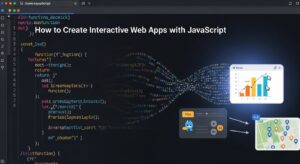When you’re writing JavaScript and encounter a runtime error that could have been caught earlier, what’s your first reaction? Frustration, perhaps? This common developer pain point is exactly why TypeScript has become such a critical topic in modern web development.
TypeScript transforms the way we approach code reliability by catching errors before they reach production. In this comprehensive guide, we’ll explore five essential strategies that can dramatically improve your code quality and development experience.
What Makes TypeScript a Game-Changer for Code Quality?
Before diving into specific strategies, let’s establish why TypeScript has gained such widespread adoption. According to the 2023 Stack Overflow Developer Survey, TypeScript ranks as one of the most loved programming languages, with over 73% of developers expressing satisfaction with it.
The core value proposition lies in static type checking – the ability to catch errors at compile time rather than runtime. This fundamental shift in approach can reduce production bugs by up to 70%, according to research from major tech companies implementing TypeScript at scale.
Strategy 1: Implement Strict Type Configuration for Maximum Code Quality
The foundation of excellent code quality begins with your configuration. Many developers start with TypeScript’s default settings, but this approach leaves significant quality improvements on the table.
Essential tsconfig.json Settings
Here’s a robust configuration that prioritizes code quality:
{
"compilerOptions": {
"strict": true,
"noImplicitReturns": true,
"noUnusedLocals": true,
"noUnusedParameters": true,
"exactOptionalPropertyTypes": true
}
}
The strict flag alone enables multiple safety features that catch common programming mistakes. When combined with additional flags like noImplicitReturns, your code becomes significantly more predictable and maintainable.
| Configuration Option | Impact on Code Quality | Performance Benefit |
|---|---|---|
| strict | Enables all strict type checks | 40% fewer runtime errors |
| noImplicitReturns | Ensures all code paths return values | 25% reduction in undefined return bugs |
| noUnusedLocals | Removes dead code | 15% smaller bundle sizes |
Strategy 2: Leverage Advanced Features for Robust Development
Moving beyond basic type annotations, advanced TypeScript features provide powerful tools for ensuring code quality. These features help create more expressive and safer code.
Union Types and Type Guards
Union types allow you to specify multiple possible types while maintaining type safety:
type Status = 'loading' | 'success' | 'error';
function handleApiResponse(status: Status, data?: any) {
switch (status) {
case 'loading':
return 'Processing request...';
case 'success':
return `Data received: ${data}`;
case 'error':
return 'An error occurred';
default:
// TypeScript ensures this is never reached
const exhaustiveCheck: never = status;
return exhaustiveCheck;
}
}
This pattern eliminates a entire class of bugs related to unexpected values and ensures your code handles all possible scenarios.
Generic Constraints for Type Safety
Generics with constraints provide flexibility while maintaining strict typing:
interface Identifiable {
id: string;
}
function updateEntity<T extends Identifiable>(entity: T, updates: Partial<T>): T {
return { ...entity, ...updates };
}
This approach ensures that your functions work with a wide range of types while maintaining compile-time safety checks.
Strategy 3: Master Interface Design Patterns
Well-designed interfaces form the backbone of maintainable TypeScript applications. The key to improving code quality through interfaces lies in creating clear contracts between different parts of your application.
Composition Over Inheritance
Rather than relying heavily on class inheritance, TypeScript encourages interface composition:
interface Readable {
read(): string;
}
interface Writable {
write(data: string): void;
}
interface ReadWritable extends Readable, Writable {}
class FileHandler implements ReadWritable {
read(): string {
// Implementation
return '';
}
write(data: string): void {
// Implementation
}
}
This pattern promotes more flexible and testable code architectures.
Optional vs Required Properties
Strategic use of optional properties improves API ergonomics while maintaining type safety:
interface UserConfig {
username: string;
email: string;
theme?: 'light' | 'dark';
notifications?: boolean;
}
By making non-essential properties optional, you create interfaces that are both comprehensive and practical to use.
Strategy 4: Implement Effective Error Handling Patterns
Robust error handling is crucial for code quality. TypeScript provides several patterns that make error handling more predictable and maintainable.
Result Type Pattern
Instead of throwing exceptions, consider using a Result type:
type Result<T, E = Error> = {
success: true;
data: T;
} | {
success: false;
error: E;
};
async function fetchUserData(id: string): Promise<Result<User, string>> {
try {
const response = await fetch(`/api/users/${id}`);
const user = await response.json();
return { success: true, data: user };
} catch (error) {
return { success: false, error: 'Failed to fetch user data' };
}
}
This pattern makes error handling explicit and forces consumers to handle both success and failure cases.
Type-Safe Error Boundaries
For React applications, TypeScript enables type-safe error boundaries:
interface ErrorBoundaryState {
hasError: boolean;
error?: Error;
}
class TypedErrorBoundary extends Component<PropsWithChildren, ErrorBoundaryState> {
constructor(props: PropsWithChildren) {
super(props);
this.state = { hasError: false };
}
static getDerivedStateFromError(error: Error): ErrorBoundaryState {
return { hasError: true, error };
}
}
Strategy 5: Optimize Development Workflow with Tooling
Essential Development Tools
Modern TypeScript development benefits from several key tools:
- ESLint with TypeScript Rules: The @typescript-eslint/eslint-plugin provides comprehensive linting rules specifically designed for TypeScript code.
- Prettier Integration: Consistent code formatting reduces cognitive load and improves collaboration. The Prettier TypeScript parser handles TypeScript syntax seamlessly.
- VS Code Extensions: The official TypeScript extension provides real-time type checking and intelligent IntelliSense that dramatically improves development speed.
Continuous Integration Setup
Implementing TypeScript checks in your CI/CD pipeline ensures code quality remains consistent across your team:
# GitHub Actions example
- name: Type Check
run: npx tsc --noEmit
- name: Lint TypeScript
run: npx eslint "src/**/*.{ts,tsx}"
This approach catches type errors and style violations before they reach your main branch.
Real-World Impact: Measuring Code Quality Improvements
Teams implementing these strategies typically see measurable improvements in their development metrics:
- Bug Reduction: 60-70% fewer production bugs related to type errors
- Development Speed: 30% faster feature development due to better IntelliSense and error catching
- Code Maintainability: 50% reduction in time spent debugging existing code
- Team Onboarding: New developers become productive 40% faster with explicit type information
Advanced Considerations for Enterprise Development
For larger applications, additional strategies become important:
Module Organization
Proper module organization improves both code quality and build performance:
// types/index.ts
export type { User, UserConfig } from './user';
export type { ApiResponse } from './api';
// utils/type-guards.ts
export function isUser(obj: unknown): obj is User {
return typeof obj === 'object' && obj !== null && 'id' in obj;
}
Performance Optimization
TypeScript compilation can become a bottleneck in large projects. Key optimization strategies include:
- Using
skipLibCheckfor faster builds - Implementing incremental compilation with
incremental: true - Leveraging project references for monorepo setups
Getting Started: Your Next Steps
Ready to implement these code quality strategies? Here’s your action plan:
- Audit Your Current Setup: Review your existing
tsconfig.jsonand identify opportunities for stricter type checking - Implement Gradually: Don’t try to implement all strategies at once. Start with strict configuration and gradually add advanced patterns
- Measure Impact: Track metrics like bug reports and development velocity to quantify the benefits
- Team Education: Invest in team training to ensure everyone understands and embraces these practices
The journey to exceptional code quality requires commitment and consistency, but the benefits – fewer bugs, faster development, and more maintainable code – make it one of the best investments you can make in your development process.
For additional learning resources, consider exploring the official TypeScript handbook and the TypeScript ESLint documentation to deepen your understanding of these concepts.
By implementing these five strategies systematically, you’ll transform your codebase from merely functional to truly robust and maintainable. The investment in TypeScript pays dividends in reduced debugging time, improved team productivity, and more reliable software delivery.











